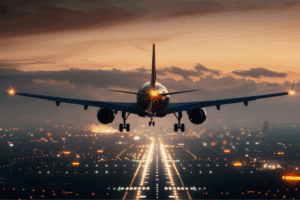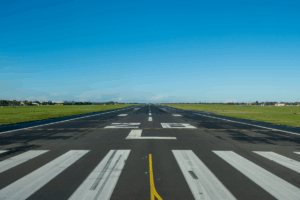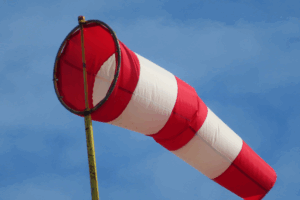Les conditions météorologiques extrêmes peuvent frapper à tout moment, en tout lieu et avec des degrés de gravité variables. Les effets des conditions météorologiques difficiles sur les appareils d'éclairage des aéroports, le câblage, l'équipement de contrôle et d'autres composants peuvent être dévastateurs pour les opérations normales, et avoir un impact significatif sur la capacité du système à assurer la sécurité des pistes et des voies de circulation.
Bien qu'il n'y ait aucun moyen d'empêcher les conditions météorologiques extrêmes de se produire, les exploitants d'aéroports peuvent prendre des mesures pour atténuer les effets sur leurs systèmes de balisage des pistes. Cependant, il est d'abord essentiel de comprendre comment la neige, le sable, les fluctuations de température et d'autres conditions et événements météorologiques peuvent avoir un impact sur l'infrastructure de balisage des pistes.
Comment les conditions météorologiques extrêmes peuvent-elles affecter les performances des systèmes d'éclairage des pistes d'aéroport ?
On ne s'attendrait pas à ce qu'un aéroport situé dans une région nordique soit confronté à la même menace météorologique qu'un aéroport situé dans un désert, mais ils ont en fait un ennemi commun : les vents à grande vitesse.
Le vent peut souffler de la neige ou du sable dans chaque crevasse exposée du système d'éclairage de l'aéroport, obstruant les pièces mécaniques ou court-circuitant les composants électriques. En outre, la neige et le sable soufflés par le vent peuvent s'accumuler devant les balises de piste, compromettant ainsi leur capacité à émettre de la lumière visible.
La glace peut également poser problème, car elle peut s'accumuler sur les lentilles et le câblage, ce qui risque d'affecter les performances de l'appareil. Lors du dégel printanier, l'eau provenant de la fonte de la glace peut s'infiltrer dans les moindres fissures de votre équipement et endommager les composants internes. L'eau peut également constituer une menace dans les zones à forte humidité ou situées dans les régions côtières, car l'air humide et salé peut corroder le métal et exposer les composants sensibles aux éléments.
Les aéroports situés dans des zones où la température fluctue fortement sont également exposés à ce risque. Par exemple, les régions qui connaissent des températures estivales torrides pendant la journée et des conditions inférieures au point de congélation pendant la nuit peuvent voir les métaux, les pièces en plastique et l'isolation du câblage de leur équipement de balisage des pistes se dilater et se contracter. S'ils ne sont pas contrôlés, ces cycles répétés peuvent entraîner des fissures dans les composants du système, rendant les connexions électriques vulnérables aux dommages.
Prévoyez des conditions météorologiques extrêmes lors de la conception de votre système
Il ne peut y avoir de compromis lorsqu'il s'agit de la sécurité des aéroports, qui exige rien de moins qu'une fiabilité constante de votre système de balisage des pistes. Vous pouvez prendre des mesures pour protéger votre équipement contre les dommages au stade de la conception du système ou lors d'une modernisation en comprenant votre environnement local et en prenant des mesures appropriées qui permettront à votre balisage de piste de fonctionner de manière fiable dans toutes les conditions météorologiques extrêmes.
Les stratégies que vous pouvez adopter pour protéger votre équipement sont les suivantes :
- Adoptez la technologie LED pour vos feux de piste, car il a été prouvé qu'ils fonctionnent de manière fiable et cohérente dans des climats soumis à de fortes fluctuations de température.
- Utiliser du matériel et des raccords fabriqués à partir de matériaux résistants à la corrosion tels que l'acier inoxydable, le titane et les alliages de titane, l'aluminium et les alliages d'aluminium, et les alliages à base de nickel qui résistent à la dégradation dans les environnements salins ou humides.
- Protégez les surfaces extérieures de vos équipements contre la rouille à l'aide de revêtements protecteurs, tels que les peintures en poudre ou les peintures spécialisées.
- Utilisez des boîtiers étanches conçus avec des caractéristiques telles que des joints d'étanchéité et des canaux de drainage pour empêcher la pénétration de l'eau et l'accumulation de condensation, ce qui vous aide à éviter les courts-circuits et les pannes d'équipement.
Plus d'informations : 5 points à prendre en compte lors de la modernisation du système de balisage des pistes d'aéroport
Entretien de l'équipement de piste de l'aéroport dans des conditions climatiques difficiles
Une fois que vous avez mis en place votre équipement résistant aux intempéries, il est essentiel de procéder à un entretien régulier afin de garantir des performances fiables et constantes. Vérifiez périodiquement le couple de serrage des boulons de fixation et des raccords, et inspectez votre équipement pour détecter tout signe de mouvement, d'inclinaison ou de déplacement après une tempête.
Une inspection visuelle régulière des ampoules, des lentilles, des câbles d'alimentation et des autres composants doit être effectuée pour s'assurer que tout fonctionne correctement. Les régions qui connaissent d'importantes chutes de neige ou de sable devront faire l'objet d'une maintenance plus fréquente afin de débarrasser les luminaires de toute accumulation de glace, de saleté, de sable ou d'autres débris susceptibles de nuire à l'éclairage. Les aéroports équipés de systèmes solaires devront également veiller à ce que les panneaux solaires ne soient pas obstrués.
Voici quelques conseils techniques supplémentaires pour protéger l'équipement des pistes de l'aéroport :
- Utiliser des luminaires conformes à la FAA et résistants au vent
- Luminaires certifiés : S'assurer que tous les appareils d'éclairage sont approuvés par la FAA (conformément à la série AC 150/5345) et qu'ils sont conçus pour résister aux charges de vent, conformément à l'instruction technique n° 67 de la FAA.
- Charge au vent : Les appareils doivent répondre à des normes minimales d'intégrité structurelle (souvent plus de 300 mph pour certaines applications).
- Luminaires à profil bas : Utiliser, dans la mesure du possible, des luminaires intégrés au trottoir ou surélevés pour réduire l'exposition au vent.
- Renforcer les systèmes de montage
- Boîtes de base et raccords : Utiliser des boîtes de base plus profondes et/ou renforcées et des raccords frangibles correctement serrés et scellés.
- Boulons d'ancrage : Ancrer solidement les appareils dans les socles en béton ou les boîtes de base à l'aide de ferrures résistantes à la corrosion.
- Bloqueurs de filets : Utiliser des composés de blocage de filets sur les boulons pour éviter qu'ils ne se desserrent sous l'effet des vibrations.
- Utiliser correctement les supports frangibles (cassants)
- Conçu pour se briser net en cas de choc ou de contrainte, les raccords frangibles réduisent le transfert de contrainte au système de montage tout en minimisant les débris en cas de vent fort
- Installer au couple correct et la hauteur conformément aux directives de la FAA (série AC 150/5340-30)
- Protéger le câblage et les conduits
- Enfouissement direct ou encastrement : Utiliser des câbles à enfouissement direct ou enterrer les conduits dans du béton ou de l'asphalte pour éviter l'exposition.
- Les bandes d'arrêt d'urgence : Ajoutez des boucles de tension ou des décharges de traction pour éviter les dommages dus à l'arrachement lorsque les appareils se déplacent sous l'effet d'une contrainte.
- Connexions étanches : Assurer l'étanchéité des raccords pour éviter les infiltrations d'humidité après une forte pluie due au vent.
- Renforcer les infrastructures critiques
Pour les systèmes clés tels que REILs, PAPIs, ODALset cônes de vent, considérer :
- Enceintes résistantes au vent et poteaux de soutien
- Câbles de haubanage ou renforcement interne dans les zones exposées aux ouragans
- Abris surélevés pour le matériel pour l'électronique
- Conception pour le souffle des réacteurs et le cisaillement du vent sur les voies de circulation
- Placement stratégique : Dans la mesure du possible, placer les feux à l'extérieur des zones connues pour le souffle des avions à réaction.
- Boucliers anti-explosion ou bermes : Installer des barrières pour rediriger le flux d'air si l'exposition est inévitable.
- Utiliser un système d'ancrage pour les installations temporaires : Pour les lampes portatives, utiliser des systèmes de haubanage et d'ancrage appropriés.
- Considérations régionales
- En zones cycloniquesLes charges de vent de catégorie 4 ou 5 sont conformes aux lignes directrices de l'OACI et de la FAA.
- Utilisation codes locaux de charge de vent (par exemple, les normes ASCE 7 ou IBC) pour déterminer les spécifications d'installation.
Plus d'informations : Routines d'entretien des systèmes d'éclairage des pistes et voies de circulation par encastrement
Une technologie de pointe qui vous aidera à maintenir des opérations efficaces
Vous pouvez également maintenir votre aéroport opérationnel en installant des technologies de pointe telles que le L-890 Système de contrôle et de surveillance du balisage lumineux des aéroports. Cet outil permet non seulement de contrôler à distance les systèmes de balisage de la piste, mais aussi de surveiller en temps réel les composants, en fournissant des alarmes et des rapports détaillés en cas de défaillance potentielle. Cette approche proactive de la maintenance du balisage vous aide à anticiper les problèmes du système entre les contrôles de maintenance programmés, améliorant ainsi la sécurité de vos opérations.
Protégez votre aéroport contre les pannes d'électricité inattendues dues à des conditions météorologiques extrêmes grâce à un système d'alarme. alimentation ferrorésonante. Ces unités empilables sont conçues pour fournir de l'énergie dans des conditions de fonctionnement extrêmes sans être affectées par les systèmes électriques environnants. Leur circuit résonant garantit des tensions de sortie constantes et fiables, même si la tension d'entrée varie en raison de l'instabilité de l'alimentation ou d'autres perturbations énergétiques.
Pour des stratégies plus efficaces afin de protéger votre équipement d'éclairage aéroportuaire contre les dommages causés par les conditions météorologiques difficiles, contacter les experts de Airport Lighting Company. Nous sommes là pour vous mettre en contact avec des solutions technologiques avancées qui garantissent la sécurité et la fiabilité de votre système d'éclairage aéroportuaire pour les décennies à venir.
Appelez le Airport Lighting Company pour obtenir les dernières technologies en matière d'éclairage des aéroports
L'équipe de Airport Lighting Company est à votre disposition pour répondre à vos questions pour savoir comment nos produits technologiques peuvent contribuer à améliorer la sécurité, la fiabilité et l'efficacité de vos pistes d'atterrissage. Appelez le 315-682-6460 pour un service rapide et amical sur lequel vous pouvez compter.


